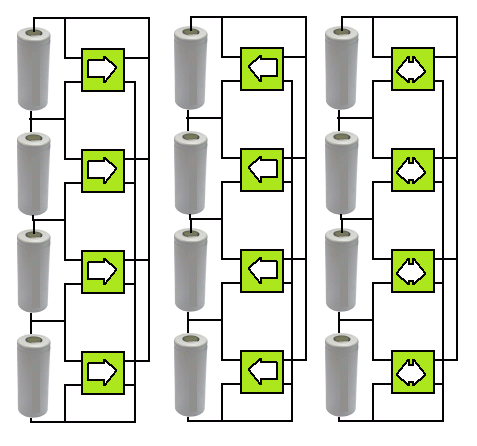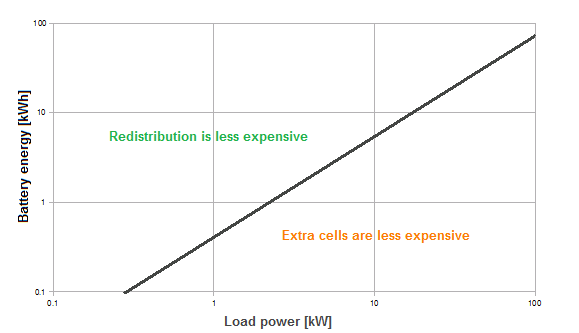
Redistribution is a technique that shuffles energy in a battery in such way that all of its energy can be used.
While discharging, it involves taking additional energy from the cells with the highest capacity, so that the cells with the lowest capacity are no longer the limiting factor in the battery capacity.
The goal of redistribution is for all the cells to start at 100% SOC at the beginning of discharge, and all end at 0 % SOC at the end of discharge.
An effect of redistribution is that the SOC of the battery and the SOC of each cell are always equal.
Redistribution is similar to active balancing. But the DC-DC converters used must handle more power, and the algorithms are a bit more complex.
|
| Balancing
| Redistribution
|
| Battery energy utilization
| ~90 %
| 100 %
|
| Battery capacity
| = minimum cell capacity
| = average cell capacity
|
| Pack SOC
| = SOC of cell with least capacity
| = SOC of all cells
|
| Cell SOC
| At some point (usually at 100 %), all cells have same SOC
| All cells always at same SOC
|
| Method
| Active or passive.
Once the battery is balanced, energy is no longer transferred
| Active only.
Dynamically transfers energy during use, during each and every cycle
|
| Current
| Low: 10mA to 1 A
| High: 10 to 100 A
|
Active balancing can be:
- Cell to battery: energy is removed from the most charged cells and sent to the entire battery
- Battery to cell: energy is removed from the entire battery and sent to the least charged cells
- Bidirectional: either of the above, depending on needs

Redistribution topologies: (L to R) Cell-to-battery; battery-to-cell; bidirectional.
This table compares the three methods.
|
| Cell to battery
| Battery to cell
| Bidirectional
|
| Type of DC-DC converter
|
- Low voltage to high voltage
|
- High voltage to low voltage (or, and bulk DC-DC converter with N switched outputs)
|
|
| Direction and operation
|
- Fed by a cell when it has excess charge
- Feeds the battery
|
- Fed by the battery
- Feeds a cell when it has insufficient charge
|
- Fed by a cells with excess charge, if those are the majority; else fed by battery
- Feeds the cells with insufficient charge, if those are the majority; else feeds the battery
|
| Pros
|
- More efficient: high voltage output rectifiers
- Simpler: low voltage transistors, controlled from same low voltage side as the cell electronics
- Most effective when only a few cells are low capacity: the majority of the converters are operating
|
- Most effective when most cells are low capacity: the majority of the converters are operating
- Can be implemented with a single, bulk, high power DC-DC converter, and many switched outputs to the cells
|
- Effective regardless of whether most cells are low capacity or high capacity
|
| Cons
|
- Not terribly efficient (in the 80s)
|
- Requires high voltage transistors
- Requires isolated control from cell electronics (low voltage side) to drive transistors (high voltage side)
- Inefficient (in the 70s): low voltage rectifiers (synchronous rectifiers may help, for additional cost and complexity)
|
- Most complex: switches on both ends
- Inefficient (in the 70s): low voltage rectifiers (synchronous rectifiers may help, for additional cost and complexity)
|
High power DC-DC converters are required for redistribution. Roughly speaking, the power required for of each converter is:
P = Average load power * variation in cell capacity / number of cells in series
By knowing each cell's capacity before hand, each converter is operated as long as necessary, as long as the entire discharge period.
For example, for a 10 kW load, +0/-10% variation in cell capacity, 100 cells in series:
P = 10 kW * 10% / 100 = 10 W
In this example, at first it may be hard to believe that 10 W DC-DC converters can power a 10 kW load.
But once you consider the following, you will see why that is:
- There are 100 converters, which may transfer up to 990 W all together (at least 1 converter will have to remain off)
- Converters can work constantly throughout the discharge period, to transfer only 10 % of the charge, giving a additional 10:1 advantage
While the technical advantage of redistribution is obvious, a cost analysis may show that it in some cases it is cheaper to add cells to the battery than to do redistribution.
Assuming:
- DC-DC converters cost $ 1 / W
- Batteries cost 0.3 / Wh
Then, if the load discharges the battery in less than 20 minutes, adding cells to the battery is cheaper that using redistribution.

Redistribution vs. extra cells: for smaller batteries, and at high power, it is cheaper to add cells.
- Redistribution makes all the energy in a battery available for use, by adding a number of DC-DC converters
- In a typical application, small DC-DC converters will be enough for a load whose power is 1000 times their power
- If the load discharges the battery faster than 20 minutes, it's cheaper to just add cells to the battery.
 "Redistribution: getting every little bit of energy out of a battery" by Davide Andrea
is licensed under a Creative Commons Attribution-Share Alike 3.0 Unported License.
Permissions beyond the scope of this license may be available by contacting the author.
"Redistribution: getting every little bit of energy out of a battery" by Davide Andrea
is licensed under a Creative Commons Attribution-Share Alike 3.0 Unported License.
Permissions beyond the scope of this license may be available by contacting the author.
Davide Andrea, Elithion, 8/14/09
 Li-Ion BMS
Li-Ion BMS


